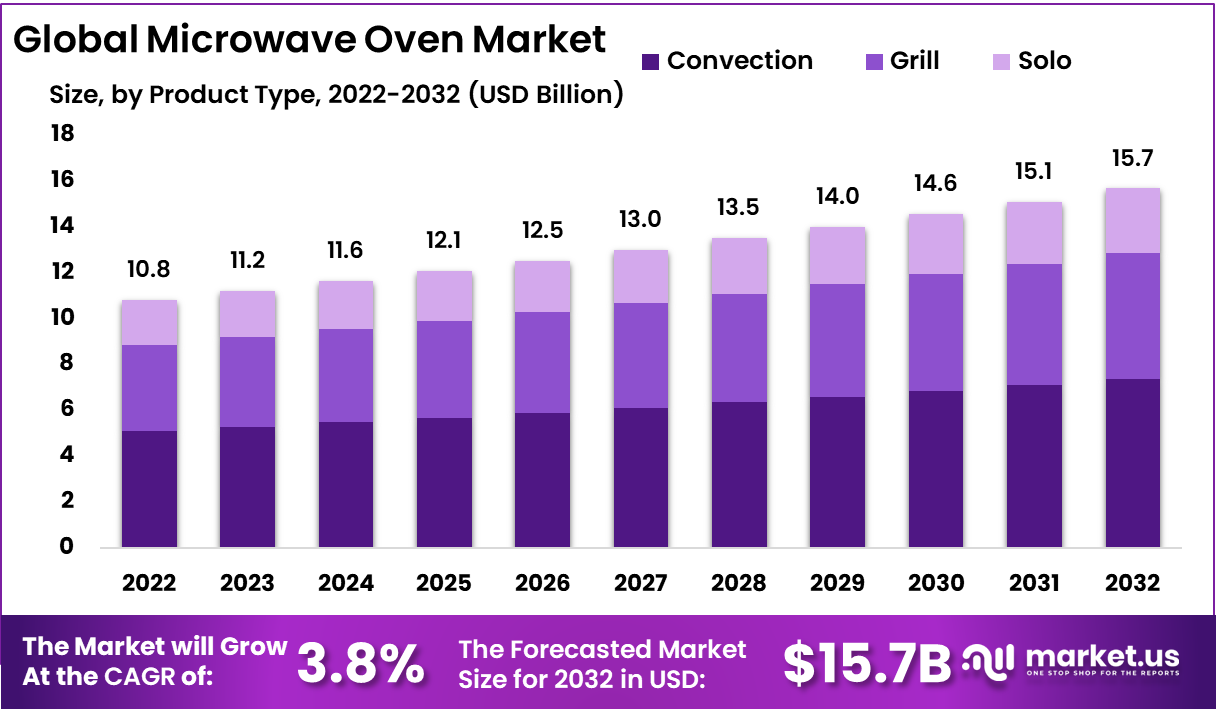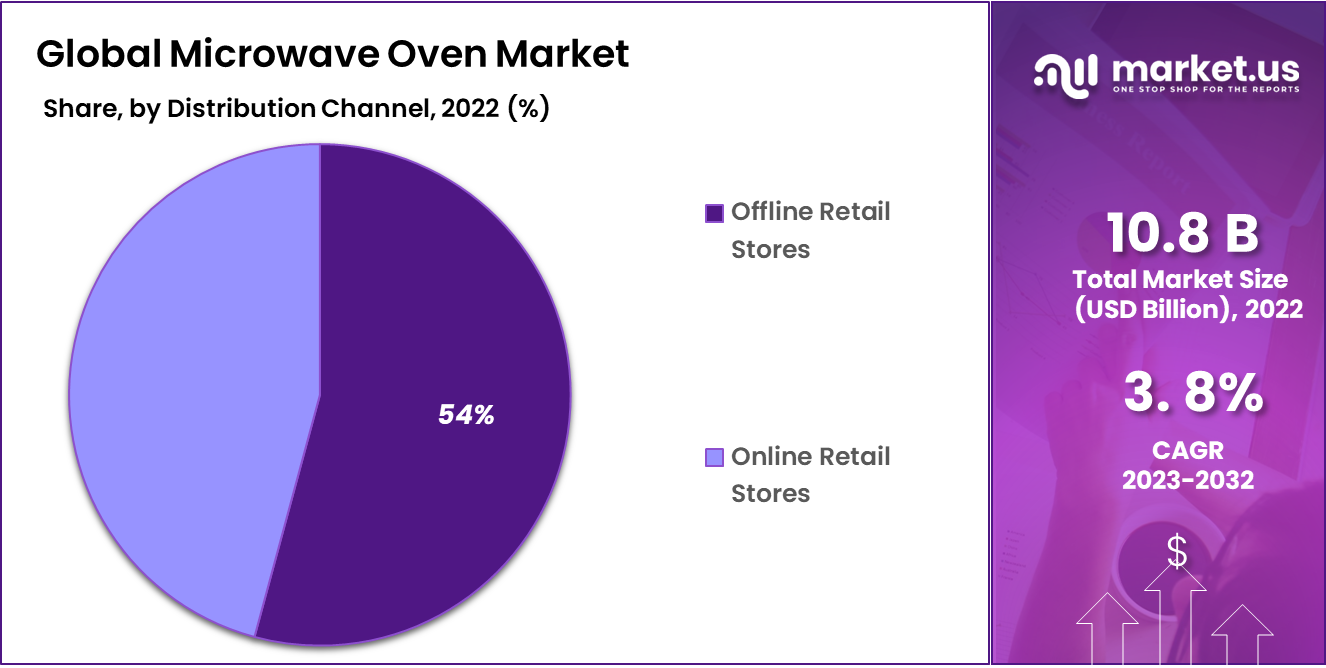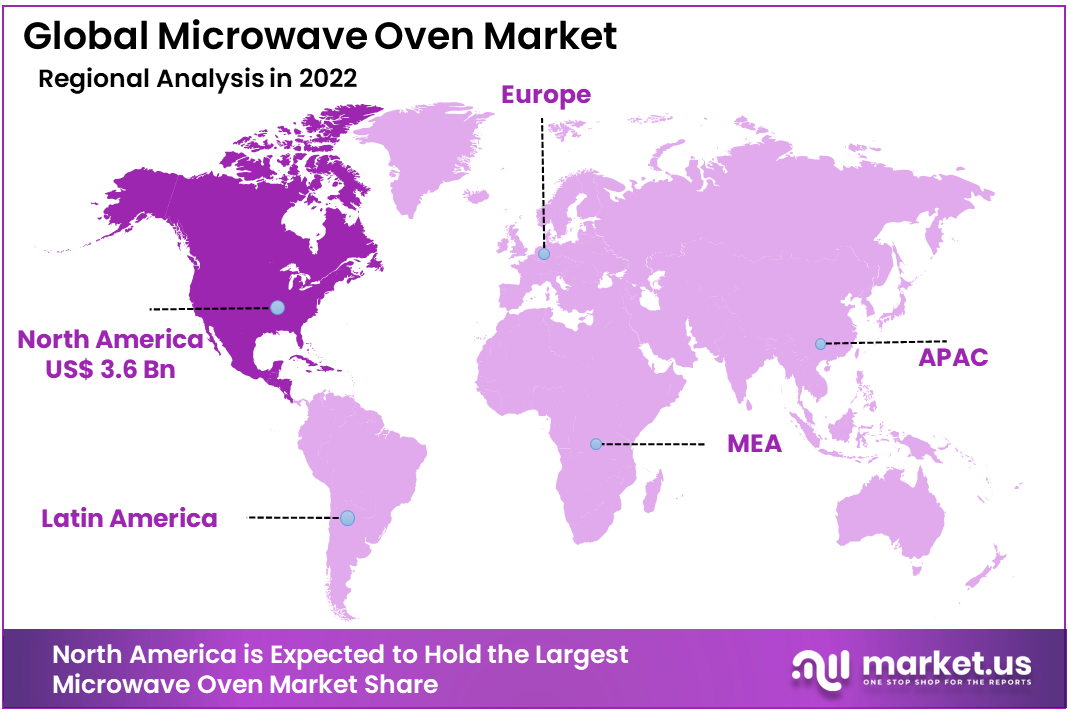Global Microwave Oven Market Size, By Product Type (Convection, Grill, and Solo), By Structure (Built-in, Countertop, and Over-the-Range), By Cooking Capacity (Small, medium, and Large), By Distribution Channel (Offline Retail Stores and Online Retail Stores), By End-Use (Household and Commercial), By Region and Companies - Industry Segment Outlook, Market Assessment, Competition Scenario, Trends, and Forecast 2023-2032
- Published date: Sep 2023
- Report ID: 34093
- Number of Pages: 345
- Format:
- keyboard_arrow_up
Quick Navigation
- Report Overview
- Key Takeaways:
- Driving Factors
- Restraining Factors
- Growth Opportunities
- Latest Trends
- Product Type Analysis
- Structure Analysis
- Cooking Capacity Analysis
- Distribution Channel Analysis
- End-Use Analysis
- Global Microwave Oven Market Segments Include:
- Geopolitics and Recession Impact Analysis
- Regional Analysis
- Market Share & Key Players Analysis
- Report Scope:
Report Overview
The Global Microwave Oven Market size is expected to be worth around USD 15.70 Billion by 2032 from USD 10.8 Billion in 2022, growing at a CAGR of 3.80% during the forecast period from 2023 to 2032.
Introduction
A microwave oven, often simply referred to as a microwave, is a kitchen appliance that has become an indispensable part of modern cooking. It has revolutionized the way we prepare and reheat food, offering convenience, speed, and versatility in the culinary world. This device employs electromagnetic waves to quickly and evenly heat or cook a wide range of dishes, making it a staple in households around the world.
With the rise of smart home technology, manufacturers are integrating Wi-Fi connectivity and smartphone apps into microwave ovens. This allows users to control and monitor their ovens remotely, access recipes, and receive notifications.

Actual Numbers Might Vary in the Final Report
Key Takeaways:
- In 2022, the global microwave oven market was valued at US$ 10.8 Billion.
- By product type, the convection microwave oven segment dominated the market with the largest market revenue share of 47% in 2022.
- By structure, the countertop segment held a major market share of 55% in 2022.
- By cooking capacity, the large microwaves segment held a major market share in 2022.
- By distribution channel, the offline segment held a major market share of 54% in 2022.
- By end-use, the household segment held a major market share of 62% in 2022.
- In 2022, North America dominated the market with the highest revenue share of 34%.
- The global microwave oven market continues to grow steadily, driven by increased demand for convenient cooking solutions and modern kitchen appliances.
- Manufacturers are focusing on incorporating advanced technologies such as inverter technology, smart features, and sensor cooking.
- The market exhibits regional variations, with different consumer preferences and cooking habits influencing microwave oven sales.
- Online sales channels are gaining importance, with consumers increasingly purchasing microwave ovens through e-commerce platforms.
- Key players like LG Electronics, Samsung Electronics, and Whirlpool Corporation continue to compete for market share through product innovation.
Driving Factors
Changing Consumer Lifestyles and Rising Urbanization Driving the Global Microwave Oven Market Growth
In recent years, consumer lifestyles have undergone a significant transformation. With people leading busier lives, the demand for convenience in cooking has surged. Microwave ovens have emerged as a kitchen staple due to their ability to quickly heat or cook food. Whether it’s reheating leftovers or defrosting frozen ingredients, microwave ovens offer a time-efficient solution for modern households.
The ongoing trend of urbanization has resulted in a growing number of people living in smaller, urban dwellings such as apartments and condos. In these compact living spaces, traditional cooking methods like gas stoves or ovens may not be feasible. Microwave ovens are a practical choice in such settings, as they are space-efficient and versatile, making them an essential appliance for urban residents.
Restraining Factors
Price Volatility and High Market Saturation Restraining the Market Growth
In many developed markets, such as North America and Europe, microwave oven penetration is extremely high. This market saturation limits the potential for significant growth in these regions as most households already own one.
Manufacturers are constantly seeking ways to encourage replacement purchases or market expansion, but it remains a challenge. Fluctuations in the prices of raw materials, such as stainless steel or electronic components, can impact manufacturing costs and, in turn, the pricing of microwave ovens.
Growth Opportunities
Technological Advancements and Rising Demand for Convenience is Expected to Create Lucrative Growth Opportunities in the Global Market
The continuous development of microwave oven technology is expected to drive market growth. Manufacturers are investing in research and development to introduce innovative features such as smart ovens with Wi-Fi connectivity, voice control, and advanced cooking functions. These technological advancements will attract consumers looking for convenient and efficient cooking appliances.
As energy costs rise and environmental concerns grow, there’s a growing emphasis on energy-efficient appliances. Manufacturers are working on designing microwave ovens with improved energy efficiency, which can reduce operating costs and appeal to eco-conscious consumers. Microwave ovens have applications beyond household cooking.
They are used in healthcare facilities for sterilization and heating medical equipment, as well as in the food service industry for quick heating and cooking. Exploring these niche markets can create additional growth opportunities.
Latest Trends
The Development of Advanced Cooking Features, Such As Inverter Technology And Multi-Stage Cooking Programs
Microwave ovens are no longer just functional appliances; they’re becoming statement pieces in modern kitchens. Manufacturers are focusing on sleek designs, premium materials, and customizable options to match various kitchen decors. Built-in microwave ovens are also gaining popularity for their seamless integration into kitchen cabinetry.
Many modern microwave ovens come with pre-programmed cooking options for specific foods, such as popcorn, pizza, or beverages. These presets simplify cooking and ensure better results, attracting consumers looking for convenience. Microwave ovens are becoming more versatile with advanced cooking features such as inverter technology, which provides consistent cooking power, and multi-stage cooking programs that allow users to set multiple power and time levels for different stages of cooking.
Product Type Analysis
The Convection Segment Dominates the Global Microwave Oven Market
Based on product type, the global microwave oven market is segmented into convection, grill, and solo. The convection microwave oven segment is the dominant segment of the global microwave oven market, with the largest market revenue share of 47% in 2022. Convection microwave ovens offer a wide range of cooking options, including baking, roasting, grilling, and reheating.
This versatility appeals to consumers looking for an all-in-one kitchen appliance, as it reduces the need for multiple devices, saving both kitchen space and money. Convection microwave ovens use a fan and heating element to circulate hot air, which cooks food faster and more evenly than traditional microwaves. This feature aligns with the modern lifestyle, where consumers seek convenience and time-saving solutions.
Structure Analysis
Countertop Segment Dominate This Market with Largest Market Share of 55% in 2022
Based on the structure, the global microwave oven market is segmented into built-in, countertop, and over-the-range. The countertop segment dominated the market with the largest market revenue share of 55% in 2022. Countertop microwave ovens are incredibly easy to install; they simply require a power outlet and enough space on your kitchen countertop. This ease of installation makes them highly attractive to consumers.
Additionally, their portability allows users to move them around as needed, which can be a significant advantage in small kitchens or when rearranging kitchen appliances. The built-in segment is expected to grow at the fastest CAGR during the forecast period. As kitchen designs evolve, built-in appliances have become a symbol of modernity and sophistication. They cater to the desire for a streamlined, uncluttered kitchen appearance, aligning with contemporary design trends.
Cooking Capacity Analysis
Large Microwaves Segment is Dominant in the Global Microwave Oven Market
Based on cooking capacity, the global microwave oven market is segmented into small (up to 20 liters), medium (21-30 liters), and large (above 31 liters). The large microwave oven segment is the dominant segment in the global microwave oven market. Large microwave ovens offer greater cooking versatility.
Their spacious interiors can accommodate larger dishes and cookware, making them suitable for preparing meals for families and larger gatherings. This versatility attracts consumers who want a single appliance that can handle a wide range of cooking tasks. Large microwaves are better suited to prepare meals for these larger families, making them an essential kitchen appliance.
Distribution Channel Analysis
The Offline Retail Stores Segment is Dominant in the Global Microwave Oven Market
Based on distribution channels, the global microwave oven market is classified into offline retail stores and online retail stores. The offline retail store segment is the dominant distribution channel for microwave ovens, with a market share of 54% in 2022. One of the primary reasons for the success of offline retail stores is that consumers often prefer to physically interact with products before making a purchase.
Microwave ovens are considered significant household appliances, and consumers want to see, touch, and sometimes even test the appliance in-store to ensure it meets their specific needs and aesthetic preferences. Physical stores are conveniently located in various neighborhoods and shopping centers, making them easily accessible to a wide range of consumers. This local presence is crucial for attracting customers who prefer to shop close to their homes.
End-Use Analysis
The Household Segment is Dominant in the Global Microwave Oven Market
Based on end-use, the global microwave oven market is segmented into commercial and household. The household segment accounted for the largest revenue share of 62% in 2022. Microwave ovens have become an integral part of modern households due to their convenience and time-saving capabilities. They enable quick and efficient heating, defrosting, and cooking of food, making them indispensable for busy families and individuals.
The fast-paced lifestyles of today’s consumers drive the demand for appliances that can reduce meal preparation time, and microwave ovens fit this requirement perfectly. The commercial segment is expected to grow at the fastest CAGR during the forecast period. The food service industry, which includes restaurants, fast-food chains, and catering services, is a major consumer of commercial microwave ovens.
The demand for convenient and quick food preparation has led to the widespread adoption of microwave ovens in commercial kitchens. Microwave ovens are used for reheating, defrosting, and cooking a variety of dishes, making them essential equipment for these businesses.

Global Microwave Oven Market Segments Include:
By Product Type
- Convection
- Grill
- Solo
By Structure
- Built-in
- Countertop
- Over-the-Range
By Cooking Capacity
- Small (up to 20 Liters)
- Medium (21-30 Liters)
- Large (Above 31 Liters)
By Distribution Channel
- Offline Retail Stores
- Online Retail Stores
By End-Use
- Commercial
- Household
Geopolitics and Recession Impact Analysis
- Consumer Spending: During a recession, consumer spending tends to decrease as people become more cautious about their finances. This can lead to a decline in the demand for microwave ovens, which are considered non-essential appliances.
- Price Sensitivity: Consumers may become more price-sensitive during a recession, looking for budget-friendly options. Microwave oven manufacturers may need to adjust their pricing strategies to cater to this change in consumer behavior.
- Market Consolidation: Economic downturns can lead to market consolidation as smaller players struggle to survive. Larger, more established microwave oven manufacturers may acquire smaller competitors or gain a larger market share, leading to increased concentration in the industry.
- Supply Chain Efficiency: Companies may streamline their supply chains to reduce costs during a recession. This can lead to changes in sourcing strategies and a focus on cost-effective production methods.
- After-Sales Services: As consumers try to prolong the lifespan of their appliances during a recession, the demand for microwave oven repair and maintenance services may increase. Companies offering such services may see growth opportunities.
Regional Analysis
North America Dominates the Global Microwave Oven Market
North America is the largest market for the global microwave oven market, with a market share of 34% in 2022. North America has witnessed significant lifestyle changes over the years, with a growing number of households opting for convenience and time-saving solutions. Microwave ovens have become an essential kitchen appliance for busy individuals and families, driving robust consumer demand.
The North American market benefits from continuous technological advancements in microwave oven design and functionality. Manufacturers have introduced features like convection cooking, smart technology, and sensor-based cooking, enhancing the appeal of microwave ovens to a tech-savvy consumer base.
The Asia Pacific market is expected to grow at the fastest CAGR during the forecast period. The Asia Pacific region is home to a significant portion of the world’s population. A growing population increases the demand for household appliances, including microwave ovens, as more people require convenient cooking solutions. Rapid urbanization in countries like China and India has led to smaller living spaces, which favor compact and efficient kitchen appliances like microwave ovens.

Key Regions and Countries Covered in this Report:
- North America
- The US
- Canada
- Europe
- Germany
- France
- The UK
- Italy
- Spain
- Russia & CIS
- Rest of Europe
- APAC
- China
- Japan
- South Korea
- India
- ASIAN
- Rest of APAC
- Latin America
- Brazil
- Mexico
- Rest of Latin America
- Middle East & Africa
- GCC
- South Africa
- United Arab Emirates
- Rest of the Middle East & Africa
Prominent companies like LG Electronics, Samsung Electronics, Panasonic Corporation, and Sharp Corporation allocate substantial resources to research and development, leading to the introduction of cutting-edge microwave oven models.
These advancements encompass features like smart connectivity, sensor-based cooking, and environmentally friendly designs, making them appealing to consumers seeking the most up-to-date technological innovations.
Market Key Players:
- LG Electronics
- Samsung Electronics
- Alto-Shaam Inc.
- Electrolux AB
- Sharp Corporation
- Whirlpool Corporation
- Panasonic Corporation
- Midea Group
- Haier Group Corporation
- Breville USA Inc.
- Robert Bosch GmbH
- Gorenje d.d.
- Daewoo Electronics
- SMEG S.p.A.
- Hisense Group
- Miele & Cie. KG
- Toshiba Corporation
- Candy Hoover Group
- BSH Home Appliances Corporation
- Galanz Group
- Sharp Corporation
- Black+Decker
- Maytag
- Cuisinart
- Other Key Players
Recent Developments:
- In January 2023, LG Electronics introduced their InstaView Neo microwave oven with AI Air Fry featuring a built-in camera and AI technology to enable users to monitor the progress of food cooking inside, adjust settings accordingly, and ensure even and speedy cooking with its AI Air Fry feature.
- In March 2023, LG Electronics announced their partnership with Amazon Alexa for their LG InstaView Neo microwave oven, allowing users to control it using voice command functions like “Alexa, start cooking my frozen meal.”
Report Scope:
Report Features Description Market Value (2022) US$ 10.8 Billion Forecast Revenue (2032) US$ 15.7 Billion CAGR (2023-2032) 3.8% Base Year for Estimation 2022 Historic Period 2016-2022 Forecast Period 2023-2032 Report Coverage Revenue Forecast, Market Dynamics, COVID-19 Impact, Competitive Landscape, Recent Developments Segments Covered By Product Type: Convection, Grill, and Solo; By Structure: Built-in, Countertop, and Over-the-Range; By Cooking Capacity: Small, medium, and Large; By Distribution Channel: Offline Retail Stores and Online Retail Stores; By End-Use: Household and Commercial. Regional Analysis North America: The US and Canada; Europe: Germany, France, The UK, Italy, Spain, Russia & CIS, and the Rest of Europe; APAC: China, Japan, South Korea, India, ASEAN, and the Rest of APAC; Latin America: Brazil, Mexico, and Rest of Latin America; Middle East & Africa: GCC, South Africa, United Arab Emirates, and Rest of Middle East & Africa. Competitive Landscape LG Electronics, Samsung Electronics, Alto-Shaam Inc., Electrolux AB, Sharp Corporation, Whirlpool Corporation, Panasonic Corporation, Midea Group, Haier Group Corporation, Breville USA Inc., Robert Bosch GmbH, Gorenje d.d., Daewoo Electronics, SMEG S.p.A., Hisense Group, Miele & Cie. KG, Toshiba Corporation, Candy Hoover Group, BSH Home Appliances Corporation, Galanz Group, Sharp Corporation, Black+Decker, Maytag, Cuisinart, Other Key Players Customization Scope Customization for segments, region/country-level will be provided. Moreover, additional customization can be done based on the requirements. Purchase Options We have three licenses to opt for: Single User License, Multi-User license (Up to 5 Users), Corporate Use License (Unlimited User and Printable PDF) Frequently Asked Questions (FAQ)
Q: List the segments encompassed in this report on the Microwave Oven market?Market.US has segmented the Microwave Oven market by geographic (North America, Europe, APAC, South America, and Middle East and Africa). By Structure, the market has been further divided into Countertop and Built-in. By Product, the market has been segmented into Convection, Solo, and Grill. By Application, the market has been further divided into Household and Commercial.
Q: List the key industry players of the Microwave Oven market?Whirlpool Corporation, Sharp Corporation, Robert Bosch GmbH, Panasonic Corporation, LG Electronics, Haier Group Corporation, Dongbu Daewoo Electronics Corporation, Electrolux AB, and Other Key Players are engaged in the Microwave Oven market
Q: Which region is more appealing for vendors employed in the Microwave Oven market?North America is expected to account for the highest revenue share of 33%. Therefore, the Microwave Oven industry in North America is expected to garner significant business opportunities over the forecast period.
Q: Name the key areas of business for Microwave Oven?The US, India, China, Canada, UK, Japan, & Germany are key areas of operation for the Microwave Oven Market.

- LG Electronics
- Samsung Electronics Co. Ltd Company Profile
- Alto-Shaam Inc.
- Electrolux AB Company Profile
- Sharp Corporation
- Whirlpool Corporation
- Panasonic Corporation Company Profile
- Midea Group
- Haier Group Corporation
- Breville USA Inc.
- Robert Bosch GmbH
- Gorenje d.d.
- Daewoo Electronics
- SMEG S.p.A.
- Hisense Group
- Miele & Cie. KG
- Toshiba Corporation Company Profile
- Candy Hoover Group
- BSH Home Appliances Corporation
- Galanz Group
- Black+Decker
- Maytag
- Cuisinart
- Other Key Players
- settingsSettings
Our Clients
| Single User $4,599 $3,499 USD / per unit save 24% | Multi User $5,999 $4,299 USD / per unit save 28% | Corporate User $7,299 $4,999 USD / per unit save 32% | |
|---|---|---|---|
| e-Access | |||
| Report Library Access | |||
| Data Set (Excel) | |||
| Company Profile Library Access | |||
| Interactive Dashboard | |||
| Free Custumization | No | up to 10 hrs work | up to 30 hrs work |
| Accessibility | 1 User | 2-5 User | Unlimited |
| Analyst Support | up to 20 hrs | up to 40 hrs | up to 50 hrs |
| Benefit | Up to 20% off on next purchase | Up to 25% off on next purchase | Up to 30% off on next purchase |
| Buy Now ($ 3,499) | Buy Now ($ 4,299) | Buy Now ($ 4,999) |












